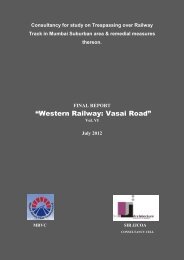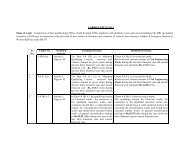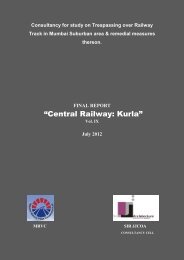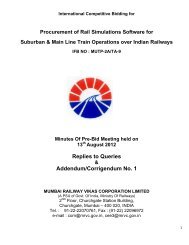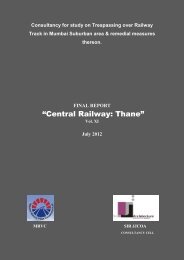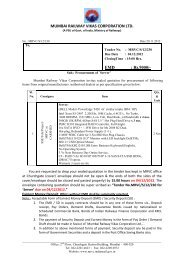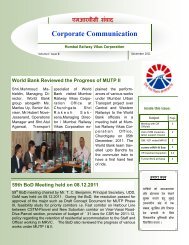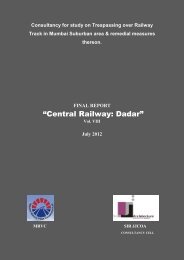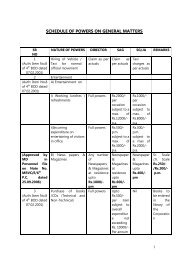World Bank Document - Mumbai Railway Vikas Corporation Ltd ...
World Bank Document - Mumbai Railway Vikas Corporation Ltd ...
World Bank Document - Mumbai Railway Vikas Corporation Ltd ...
You also want an ePaper? Increase the reach of your titles
YUMPU automatically turns print PDFs into web optimized ePapers that Google loves.
IV.<br />
APPRAISAL SUMMARY<br />
A. Economic and financial analyses<br />
44. Economic analysis: Since this project is a continuation of the earlier MUTP-1<br />
project, the economic analysis for this project has been conducted comparing the proposed<br />
additional project components as the ‘with’ alternative against the situation at the end of MUTP-<br />
1 as the ‘without’ alternative.<br />
45. The analysis has been carried out of the project’s incremental costs and benefits.<br />
The economic analysis for the suburban rail component done at the stage of MUTP-1 has been<br />
updated to current prices. The assumptions have been modified after comparing the results of the<br />
earlier analysis with the actual outputs for traffic, average trip length, increase in other traffic<br />
(passengers and freight), procurement of rakes and the cost of various components. The revised<br />
assumptions were then used to add the proposed components (MUTP-2A) and their costs to<br />
estimate the total benefits of the whole project. The difference in costs and benefits for MUTP-1,<br />
‘with’ and ‘without’ MUTP-2A were computed to arrive at the economic rate of return for the<br />
proposed component.<br />
46. The evaluation shows that the project will have an economic rate of return of 17<br />
percent and net present value, discounted to 2010, of US$262 million in 2008 prices at a 12<br />
percent discount rate over a thirty-five-year evaluation period (2010 to 2045). The above results<br />
indicate that the project is very viable economically and the <strong>Mumbai</strong> city will gain from the<br />
better suburban system, the lifeline for commuter transport in the city. Detailed analysis is<br />
provided in Annex 9.<br />
47. Financial analysis: MRVC has made financial projections of the <strong>Mumbai</strong><br />
suburban system over a 35-year period, based on 2008-09, and related them to the overall<br />
financial performance of IR. It took into account the impact of both the on-going MUTP-1<br />
(assumed to be completed in 2010-11) and MUTP-2A (assumed to be completed in 2014-15). A<br />
Base Case analysis was undertaken, as well as sensitivity analyses for the key assumptions. The<br />
model was originally developed as part of the Financial and Institutional Study of the <strong>Mumbai</strong><br />
Suburban System in 1996 and has since been used regularly to forecast demand, earnings and<br />
operating expenses, generally performing well.<br />
48. In 2008-09, the <strong>Mumbai</strong> system represented an estimated 12 percent of IR’s<br />
passenger traffic (measured in passenger-km) and about seven percent of IR’s total traffic<br />
including freight. However, because of the very high average loads carried and the low average<br />
fare, it only generated about 1.5 percent of IR’s total revenue and about two percent of its total<br />
working expenses (excluding depreciation). Because MUTP-2A will reduce over-crowding and<br />
thus require more assets and services to carry the same volume of traffic, its financial<br />
performance is likely to deteriorate for at least the medium-term. However, its comparatively<br />
small share of the total IR business means that it will have only a minor impact on the financial<br />
performance of IR as a whole, which is far more dependent on railway-wide tariff policies and<br />
continued strong growth in freight traffic. Detailed financial analysis is given in Annex 9.<br />
12





